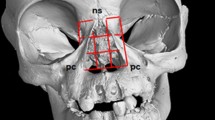Abstract
The infraorbital canal in the Japanese macaque is composed of main and accessory canals. However, the morphological features of the infraorbital canal, such as the canal course and the supply of infraorbital vessels and nerves in the maxilla, are poorly characterized. In this study, we show the structure of the infraorbital canal of the Japanese macaque (adults; 10 male, 9 female), including the distribution of these vessels and nerves, using cone-beam computed tomography and a macroscopic apparatus. The superior and lateral margins of the orbit were correlated with the infraorbital canal on three-dimensional reconstruction images (P < 0.05). We classified three types of multi infraorbital foramina as follows: type 1 had one accessory foramen, type 2 had two accessory foramina, and type 3 had three accessory foramina in the infraorbital canal. The infraorbital canal also formed three structures, specifically, a tube-like shape, a funnel shape, and a pinched shape. The accessory canals also contained nerves and blood vessels, and the canals ran downward and supplied the maxillary sinus, teeth, and midfacial region of the craniofacial skeleton, while passing through a few branch canals. These accessory canals proved valuable for blood vessels and nerves and allowed us to recognize the maxilla in the Japanese macaque skull.









Similar content being viewed by others
References
Aziz SR, Marchena JM, Puran A (2000) Anatomic characteristics of the infraorbital foramen: a cadaver study. J Oral Maxillofac Surg 58:992–996
Bressan C, Geuna S, Malerba G, Giacobini G, Giordano M, Robecchi MG, Vercellino V (2004) Descriptive and topographic anatomy of the accessory infraorbital foramen. Clinical implications in maxillary surgery. Minerva Stomatol 53:495–505
Hu KS, Kwak HH, Song WC, Kang HJ, Kim HC, Fontaine C, Kim HJ (2006) Branching patterns of the infraorbital nerve and topography within the infraorbital space. J Craniofac Surg 17:1111–1115
Hu KS, Kwak J, Koh KS, Abe S, Fontaine C, Kim HJ (2007) Topographic distribution area of the infraorbital nerve. Surg Radiol Anat 29:383–388
Hwang K, Suh MS, Chung IH (2004) Cutaneous distribution of infraorbital nerve. J Craniofac Surg 15:3–5
Iwamoto M, Watanabe T, Hamada Y (1987) Eruption of permanent teeth in Japanese monkeys (Macaca fuscata). Primate Res 3:18–28
Kazkayasi M, Ergin A, Ersoy M, Bengi O, Tekdemir I, Elhan A (2001) Certain anatomic relations and precise morphometry of the infraorbital foramen-canal and groove: an anatomical and cephalometric study. Laryngoscope 111:609–614
Kazkayasi M, Ergin A, Ersoy M, Tekdemir I, Elhan A (2003) Microscopic anatomy of the infraorbital canal, nerve, and foramen. Otolaryngol Head Neck Surg 129:692–697
Koppe T, Rae TC, Swindler DR (1999) Influence of craniofacial morphology on primate paranasal pneumatization. Ann Anat 181:77–80
Lee UY, Nam SH, Choi KN, Kim TJ (2006) Morphologic characteristics of the infraorbital foramen and infraorbital canal using three-dimensional models. Surg Radiol Anat 28:115–120
Mardinger O, Abba M, Hirshberg A, Schwartz-Arad D (2007) Prevalence, diameter and course of the maxillary intraosseous vascular canal with relation to sinus augmentation procedure: a radiographic study. Int J Oral Maxillofac Surg 36:735–738
Matsukawa M, Ryumon A, Furuhara H, Masuda S (1969) Stereological studies on several ducts and vessels by injection method of acrylic resin. XXII. On the superficial temporal artery of Macacus cynomolgos. Okajimas Folia Anat Jpn 45:267–278
Murakami G, Ohtsuka K, Sato I, Moriyama H, Shimada K, Tomita H (1994) The superior alveolar nerves: their topographical relationship and distribution to the maxillary sinus in human adults. Okajimas Folia Anat Jpn 70:319–328
Okuda Y, Okuda K, Shinohara M, Kitajima T (2000) Use of computed tomography for maxillary nerve block in the treatment of trigeminal neuralgia. Reg Anesth Pain Med 25:417–419
Olopade JO, Onwuka SK (2009) Morphometric analysis of the skull of the Sahel goat breed: basic and clinical anatomy. Ital. J Anat Embryol 114:167–178
Rae TC, Koppe T (2003) The term “lateral recess” and craniofacial pneumatization in old world monkeys (Mammalia, Primates, Cercopithecoidea). J Morphol 258:193–199
Rahman M, Richter EO, Osawa S, Rhoton AL (2009) Anatomic study of the infraorbital foramen for radiofrequency neurotomy of the infraorbital nerve. Neurosurgery 64:423–428
Rath EM (2001) Surgical treatment of maxillary nerve injuries. The infraorbital nerve. Atlas Oral Maxillofac Surg Clin North Am 9:31–41
Rosano G, Taschieri S, Gaudy JF, Weinstein T, Del Fabbro M (2011) Maxillary sinus vascular anatomy and its relation to sinus lift surgery. Clin Oral Implants Res 22:711–715
Scarfe WC, Langlais RP, Ohba T, Kawamata A, Maselle I (1998) Panoramic radiographic patterns of the infraorbital canal and anterior superior dental plexus. Dentomaxillofac Radiol 27:85–92
Sola C, Raux O, Savath L, Macq C, Capdevila X, Dadure C (2012) Ultrasound guidance characteristics and efficiency of suprazygomatic maxillary nerve blocks in infants: a descriptive prospective study. Pediatric Anesthesia 22:841–846
Solar P, Geyerhofer U, Traxler H, Windisch A, Ulm C, Watzek G (1999) Blood supply to the maxillary sinus relevant to sinus floor elevation procedures. Clin Oral Implants Res 10:34–44
Song WC, Kim JN, Yoo JY, Lee JY, Won SY, Hu KS, Kim HJ, Koh KS (2012) Microanatomy of the infraorbital canal and its connecting canals in the maxilla using 3-D reconstruction of microcomputed tomographic images. J Craniofac Surg 23:1184–1187
Traxler H, Windisch A, Geyerhofer U, Surd R, Solar P, Firbas W (1999) Arterial blood supply of the maxillary sinus. Clin Anat 12:417–421
Zumpano MP (2002) Size and shape changes during late fetal growth (137–157 gestational days) in the pigtailed macaque (Macaca nemestrina) craniofacial complex: an application using three-dimensional coordinate data and finite element scaling analysis. Anat Rec 267:307–320
Zumpano MP, Richtsmeier JT (2003) Growth-related shape changes in the fetal craniofacial complex of humans (Homo sapiens) and pigtailed macaques (Macaca nemestrina): a 3D-CT comparative analysis. Am J Phys Anthropol 120:339–351
Conflict of interest
None.
Author information
Authors and Affiliations
Corresponding author
Rights and permissions
About this article
Cite this article
Zaizen, T., Sato, I. A morphological study of the multi infraorbital canals of the maxilla in the Japanese macaque by cone-beam computed tomography. Anat Sci Int 89, 171–182 (2014). https://doi.org/10.1007/s12565-013-0216-8
Received:
Accepted:
Published:
Issue Date:
DOI: https://doi.org/10.1007/s12565-013-0216-8




